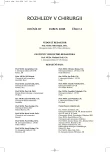Experience With Ventral Hernioplasties According to Chevrel With „On-lay“ Prolene Mesh
Authors:
M. Huťan ml.; M. Huťan
Authors‘ workplace:
IV. chirurgická klinika LF UKo a FNsP Bratislava, pracovisko Ružinov, Slovenská republika
prednosta: doc. MUDr. M. Huťan, CSc.
Published in:
Rozhl. Chir., 2008, roč. 87, č. 4, s. 190-194.
Category:
Monothematic special - Original
Overview
The authors present a retrospective study including 85 patients with ventral hernias Chevrel technique repairs. The study group included 33 males and 52 females, the mean age was 56.09 years. The procedure was indicated for incisional hernias in 58.8 % and for supraumbilical (epigastric) hernias in 25.9%.
The aim of the retrospective study was to assess the Chevrel methodology in our patients. The following parametres were assessed: postoperative quality of life, patient satisfaction rates, complication rates and relaps rates. Furthermore, the authors intended to compare the outcomes of the Chevrel repair method with other, commonly used repair methods.
The analysis had a form of questionnaires, with 39 (45.8%) patient respondents. The questionnaires were evaluated using a modified table and contingent tables in MS Excel. The authors focused, primarily, on the preoperative period and the postoperative quality of life.
On average, the patients noticed the developed hernias 23.48 months prior to their surgery. In 72% of the patients, the hernia developed after surgeries, the mean time was 21.51 months after the preceding procedure. Over a half of the cases of incisional hernias included incisional hernias after appendectomies and cholecystectomies. The majority of postoperative complications included inflammation and incisional pain. 61.5% of the patients used abdominal belts after the procedure, 5% of the patients had to change their jobs and retired due to their invalidity. The patients assessed their quality of life on the following scale: 1 (the worst) to 10 (the best). 71.8 % of the patients reported postoperative improvement in their quality of life. 59 % of the patients reported complete satisfaction with the procedure, 79.5% of the patients reported overall satisfaction (7 – 10/10). The results clearly showed that the patient satisfaction rate depended on a surgeon, which makes the choice of a surgeon the risk factor of the procedure. In the study group, the relaps rate of 10.2% and the complication rate of 25% were recorded.
The Chevrel method of relaxing incision and on-lay application of the prosthesis appears as a simple, safe, cheap and effective method of surgical management of ventral hernias with good outomes and susequent patient satisfation.
Key words:
incisional hernia – Chevrel repair – ventral hernia
Sources
1. Read, R. C., Yoder, G. Recent trends in the management of incisional herniation. Arch. Surg., 1989; 124 : 485–488.
2. Rucinski, J., Margolis, M., Panagopoulos, G., et al. Closure of the abdominal midline fascia: Meta-analysis delineates the optimal technique. Am. Surg., 2001; 67 : 421–426.
3. Townsend, C. M., Beuchamp, R. D., Evers, B. M., Mattox, K. L. Sabiston Textbook of Surgery, 18th ed., Philadelphia, USA, Saunders Elsevier, 2008, 1171–1175.
4. Paul, et al. Mayo duplication in treatment of incisional hernia of the abdominal wall after convetional laparotomy. Zentralbl. Chir., 1997; 122(10): 862–870
5. Langer, C. Twenty-five years of experience in incisional hernia surgery. Chirurg, 2003, Jul; 74(7): 638–645.
6. Burger, J. W., et al. Long-term follow-up of a randomized controlled trial of suture vs. mesh repair of incisional hernia Ann. Surg., 2004, Oct; 240(4), 578–583, disc. 583–585.
7. Leber, G. E., Garb, J. L., Alexander, A. I., et al. Long-term complications associated with prosthetic repair of incisional hernias. Arch. Surg., 1998; 133 : 378–382.
8. Huťan, M., Šalapa, M., Jamriška, J. Kóriový transplantát v rekonštrukcii ventrálnych hernií. Bratisl. lek. listy, 95, 1994, 5, s. 228–231.
9. Stoppa, R. E. The treatment of complicated groin and incisional hernias. World J. Surg., 1989; 13 : 545–554.
10. Rives, J., Pire, J. C., Flament, J. B., et al. Treatment of large eventrations. New therapeutic indications apropos of 322 cases. Chirurgie, 1985; 111 : 215–225.
11. Chevrel, J. P. The surgical treatment of incisional hernias, Hernia, 1, 1997, 1, s. 8–16.
12. deVries Reilingh, T. S., van Goor, H., Rosman, C., et al. Components separation technique for the repair of large abdominal wall hernias. J. Am. Coll. Surg., 196 : 32–37, 2003.
13. Langer, C., Schaper, A., Liersch, T., Kulle, B., Flosman, M., Füzesi, L., et al. Prognosis factors in incisional hernia surgery: 25 years of experience. Hernia, 2005; 9 : 16–21.
Labels
Surgery Orthopaedics Trauma surgeryArticle was published in
Perspectives in Surgery

2008 Issue 4
Most read in this issue
- Patient Quality of Life Following Resection Procedures for Chronic Pancreatitis
- Experience With Ventral Hernioplasties According to Chevrel With „On-lay“ Prolene Mesh
- Chronic pancreatitis, Indications for Resection Procedures and Postoperative Complications
- Our Experience with Pancreatic Resection Procedures. Retrospective Analysis
